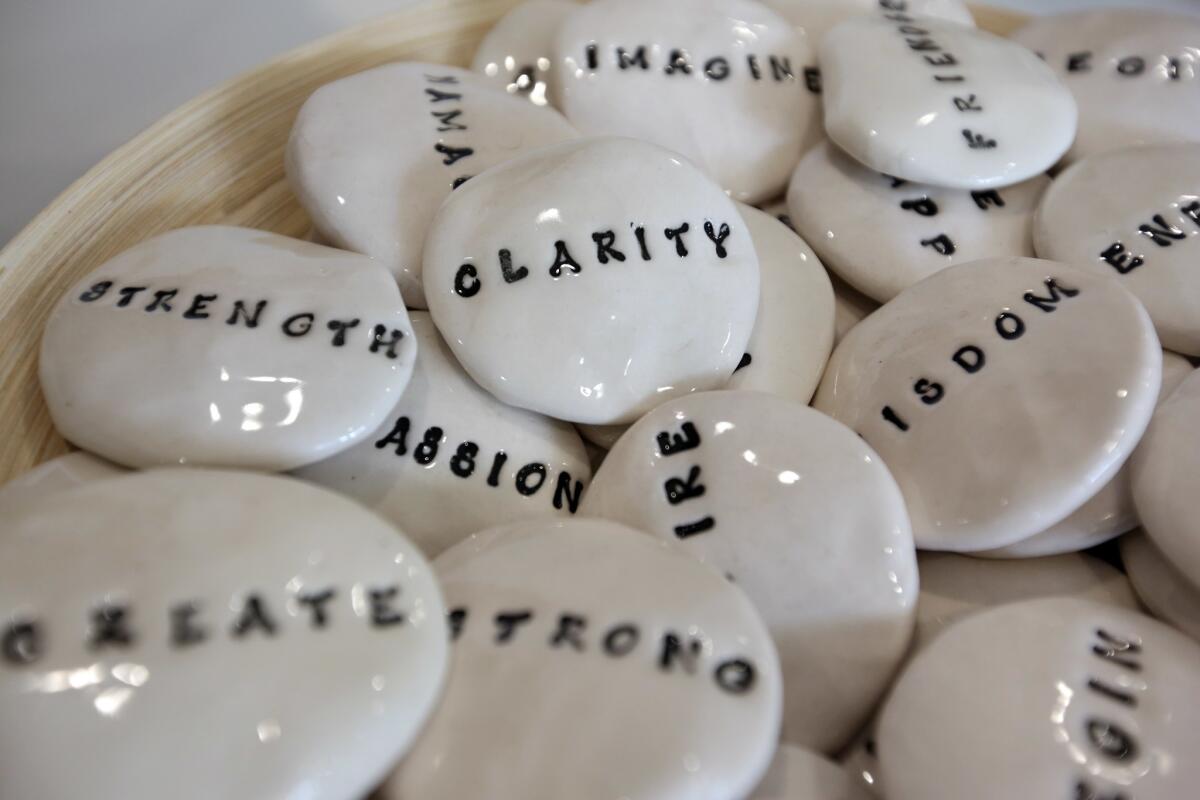5 mental tricks to help you manage stress and be more ‘mindful’ in 2017

- Share via
If there’s one thing that 2016 has taught many of us, it’s that it helps to have a way to calm our minds and quiet our hearts. Just how do you do that? Try “mindfulness.”
That, essentially, means being more attuned to what’s going on around you and inside of you. “Mindfulness is an open-hearted way of being aware of the flow of moment-to-moment experience as it’s happening,” explains Trudy Goodman Kornfield, founding teacher of mindfulness center InsightLA.
If you’re the resolution-setting kind of person, then employing mindfulness could help you find more success in reaching your goals.
Say exercise is on your 2017 to-do list but you keep avoiding the gym. Through practicing mindfulness, you can notice there is a feeling of dislike percolating inside and know that “you don’t have to take it so seriously,” says Diana Winston, director of Mindfulness Education at UCLA’s Mindful Awareness Research Center and co-author of “Fully Present: The Science, Art and Practice of Mindfulness.”
“It’s just a feeling happening in the moment. It will pass, like all feelings do,” she says.
Here are five ideas experts Goodman Kornfield and Winston offered via email on how to introduce the power of mindfulness to your routine in the coming year.
First, just STOP.
“When you’re in the middle of a stressful moment, or just want to be more mindful, remember to STOP,” Winston says.
The acronym stands for slow into the moment, take a breath, observe what’s happening before you proceed.
“Maybe your heart is racing or your stomach is clenched, or you’re anxious,” Winston says. “By taking breaths and noticing the emotion, we can calm our body and mind, we can observe what is happening without reacting, and can proceed with more awareness.”
Goodman Kornfield says, “You can simply feel your feet on the floor, your body in the chair, and take a conscious breath in to energize. Then, as you release the breath, you’ll notice a shift into a bit more relaxation and calm.” And then repeat it.
Breathe in and out.
Whether walking down the hall or to your car, you can focus on how you’re breathing as you do it, noticing how many steps happen with each breath and what’s going on in your head — taking inventory of sense throughout your whole body as you go.
“We use the breath as a bridge from activities that are usually automatic,” says Goodman Kornfield, “to being more appreciative and aware of things we ordinarily don’t even notice — thoughts, feelings, perceptions that are the landscape of our life.”
Mindfulness, a meditation practice at its heart, “is also a quality of attention that you can develop at any moment, Winston says. Starting with a basic focus on breathing is key.
“The simplest instructions are to notice the sensation of your breath in your abdomen or chest, or nose. Try to stay with one breath at a time,” she says. “When your mind wanders — and it will wander — simply bring it right back to the sensations of breathing.”
UCLA’s website offers free meditations you can download, including some five-minute ones to get started.
Snap to it.
Sometimes, all it takes to break the cycle is a simple act.
“There is nothing quicker to change than our minds,” Goodman Kornfield says. “Even if it’s just the moment of a finger-snap, when you focus your mind on being attentive, with warmth, friendliness, and care, you’re doing something good for yourself and your loved ones, and for our world.”
Listen before you leap.
We can apply mindfulness to listen — and hear — one another more effectively.
“Mindfulness is not merely a navel-gazing activity, but we can use the quality of presence we cultivate through meditation to fully show up with another human being,” Winston says. “We can listen to them fully without jumping in or trying to fix them. We can be aware of our own internal reactions and judgments and put them aside so that we can really hear another.”
Focus for the whole family.
One resource both women suggested for families is a new book called “Mindful Games” by Susan Kaiser Greenland. “There’s something for kids of all ages,” says Goodman Kornfeld. She also notes that adults can teach their kids best by modeling “mindful responses, by showing kids what’s possible with their own understanding and behavior.”
Winston, who has a 7-year-old daughter, says they do simple things at home to encourage and nurture focus and calm. “Before we eat some meals, we hold hands and take a breath together. We sometimes ring a bell and listen to the sound of the bell until we can’t hear it anymore. In bed, we practice breathing awareness.”
When it comes to mindfulness for kids, it doesn’t have to mean sitting or being still. Young children need to move their bodies. Goodman Kornfield recently taught mindfulness in a refugee-led preschool called Little Ripples in the Darfuri Refugee Camp Goz Amer in Chad. “Both the teachers and the children enjoyed opening their senses and tuning in to the present moment through drumming, dancing, singing.”
Teenagers, she says, may enjoy mindfulness group experiences that help them make friends with themselves, as well as with others.
While these five techniques can help address stress triggers and help focus your energy, none is a quick fix.
That said, however you are entering 2017 — exhausted or energized, full of hope or trepidation — “the practice of open-hearted mindfulness is an antidote to the fears we humans all have,” Goodman Kornfield says. “Our minds and hearts are quick to change — we can do it right now, in the snap of a finger.”
What are you doing to be more present in 2017? Share your thoughts in the comments below.
To read the article in Spanish, click here
Chat me up on Twitter: @mmaltaisLA
ALSO
7 L.A.-specific resolutions to make in 2017
Get dirty, get fit with mud run primer and giant expo
Guys, Taboo of the Black Eyed Peas wants you to man up and get a cancer check







